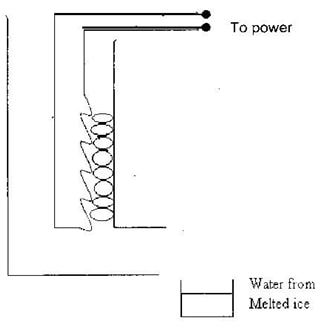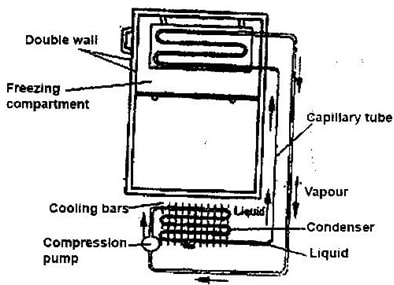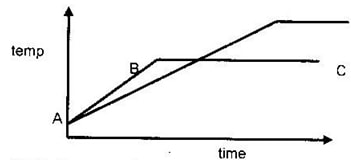Questions
- An electric heater rated 6000W is used to heat 1kg of ice initially at -100c until all the mass turns to steam. Given that
Latent heat of fusion =334kJ
Specific heat capacity of ice= 2,260J kg-1 K-1
Specific heat capacity of water = 4,200J kg-1K-1
Latent heat of vaporization = 2,260KJkg-1K-1
Calculate the minimum time required for this activity. -
- Explain why a burn from the steam of boiling water more severe that of water itself?
- An energy saving stove when burning steadily has an efficiency of 60%. The stove melts 0.03kg of ice at 00c in 180 seconds.
Calculate; -- The power rating of the stove.
- The heat energy wasted by the stove.
- A pump uses a mixture of petrol and alcohol in the ratio 4:1 by mass to raise 100kg of water from a well 200m deep.
- How much energy is given by 1g of mixture?
- If the pump is 40% efficient, what mass of this mixture is needed to raise the water?
-
- Suggest two energy changes that accompany the changing of a liquid in a vapour phase.
- Explain why the time calculated in (i) above is minimum
- An immersion heater rated 90W is placed in a liquid of mass 2kg. When the heater is switched on for 15 minutes, the temperature of the liquid rises from 200C to 300C. Determine the specific heat of the liquid.
- State two factors that would raise the boiling point of water to above 1000c
-
- State what is meant by the term specific latent heat of vaporization
- In an experiment to determine the specific latent heat of vaporization of water, steam at 1000c was passed into water contained in a well-lagged copper calorimeter. The following measurements were made:
Mass of calorimeter = 50g
Initial mass of water = 70g
Final mass of calorimeter + water + condensed steam = 123g
Final temperature of mixture = 300C
(Specific heat capacity of water = 4200 JKg-1K-1 and specific heat capacity for copper = 390JKg-1K-1)
Determine the- Mass of condensed steam
- Heat gained by the calorimeter and water
- Given that L is the specific latent heat of evaporation of steam
- Write an expression for the heat given out by steam
- Determine the value of L.
- A heating element rated 2.5 KW is used to raise the temperature of 3.0 kg of water through 500C. Calculate the time required to effect this. (Specific heat capacity of water is 4200 J/KgK)
- An electric heater is connected to the mains supply. A fault in the mains reduces the supply potential slightly. Explain the effect on the rate of heating of the heater. (3mk)
- In an experiment to determine the power of an electric heater, melting ice was placed in a container with an outlet and the heater placed in the ice as shown in the figure below. The heater was connected to a power supply and switched on for some time. The melted ice was collected.

- Other than the current and voltage, state the measurement that would be taken to determine the quantity of heat absorbed by the melted ice in unit time. (2mks)
- If the latent heat of fusion of ice is L, show how measurements in (i) above would be used in determining the power P, of the heater, (2mks)
- It is found that the power determined in this experiment is lower than the manufacturer’s value indicated on the heater. Explain. (1mk)
- The figure below shows the variation of temperature ‘θ’ with time t, when an immersion heater is used to heat a certain liquid. Study the figure and answer questions a and b.
- State the reason for the shape of the graph in the section labelled BC. (1mk)
- Sketch on the same axes the graph for another liquid of the same mass but higher specific heat capacity when heated from the same temperature. (1 mk)
- State two factors that affect the melting point of ice. (2mks)
-
- Define the term specific latent heat of vaporization of a substance. (1mk)
- The figure below shows the features of a domestic refrigerators. A volatile liquid circulates the capillary tubes under the action of the compression pump.

- State the reason for using a volatile liquid. (1mk)
- Explain how the volatile liquid is made to vaporize in the cooling compartment and to condense in the cooling fins. (2mks)
- Explain how cooling takes place in the refrigerator. (3mks)
- What is the purpose of the double wall? (1mk)
- Steam of mass 3.0g at 1000c is passes into water of mass 400g at 100c. The final temperature of the mixture is T. The container absorbs negligible heat. (Specific latent heat of vaporization of steam= 2260 kJ/kg, specific heat capacity of water= 4200Jk-1)
- Derive an expression for the heat lost by the steam as it condenses to water at temperature T. (2mks)
- Derive an expression for the heat gained by the water. (2mks)
- Determine the value of T. (2mks)
- A can together with stirrer of total head capacity 60j/k contains 200g of water at 100 c. dry steam at 1000c is passed in while the water is stirred until the whole reaches a temperature of 300c Calculate the mass of steam condensed.
- An immersion heater which takes a current of 3A from 240V mains raised the temperature of 10kg of water 300c to 500c. How long did it take?
- 100g of boiling water are poured into a metal vessel weighing 800g at a temperature of 200c if the final temperature is 500c. What is the specific heat capacity of the metal? (Specific Heat capacity of water 4.2 x 103J/kgk)
- 0.02kg of ice and 0.01kg of water 00c are in a container. Steam at 1000c is passed in until all the ice is just melted. How much water is now in the container?
- In a domestic oil-fired boiler, 0.5kg of water flows through the boiler every second. The water enters the boiler at a temperature of 300c and leaves at a temperature of 700c, re-entering the boilers after flowing around the radiators at 300c. 3.0x 107J of heat is given to the water by each kilogram of oil burnt. The specific heat capacity of water is 4200Jkg-1K-1
- Use the information above to calculate the energy absorbed by the water every second as it passes through the boiler
- Use the same information above to calculate the mass of oil which would need to be burnt in order to provide this energy.
- You are provided with two beakers. The first beaker contains hot water at 700c. The second beaker contains cold water at 200c. The mass of hot water is thrice that of cold water. The contents of both beakers are mixed. What is the temperature of the mixture?
- Calculate the heat evolved when 100g of copper are cooled from 900c to 100c. (Specific Heat Capacity of Copper = 390J/Kgk).
- An-immersion heater rated 150w is placed in a liquid of mass 5 kg. When the heater is switched on for 25 minutes, the temperature of the liquid rises from 20 - 2700c. Determine the specific heat capacity of the liquid. (Assume no heat losses)
Answers
-
- Heat absorbed by ice from – 100 = 1x 2,100 x 10 = 2.1 x 104
Heat absorbed by melting ice= 1 x 334 x 104 = 3.34 x 105
Heat absorbed by water from 00 to 1000 = 1 x 4,200 x 100J = 4.2 x 106J
Heat absorbed water at 1000 = ML = 1 x 2,260 x 103 J= 2.26 x 106J.
Total heat absorbed = 301.5 x 104 = 3.035 x 106J
Heat given out by heater = power x time
Time = 3.035 x 106
6 x 103
= 0.5025 x 103
= 505 .83s = 8.43min - Some heat is used to heat up the heater, some is absorbed by the container/ due to energy losses more time for heating will be required.
- Heat absorbed by ice from – 100 = 1x 2,100 x 10 = 2.1 x 104
-
- It has more heat energy than water at the same temperature.
-
- At 60%, Q = ML = 0.03 x 3.36 x 105
At 100% power = 93.3 V or
P = E= 0.03 x 3.36 x 105
T 100
= 56W - 100% energy = 100 x 10080
60
= 16,800J
∴ 40 x 16,800 = 6,720J
= 60J
- At 60%, Q = ML = 0.03 x 3.36 x 105
-
- 1/5g alcohol gives 5.4 x 103J
4/5 petrol gives 38.4 x 103J
1g mixture gives (5.4 x 103 J) + (38.4 x 103J) - Work done= Mgh = 1000 x 20x 10
1,000 x 20 x 10 x 100 = 1.14 x 102g
43.8 x 103 40
OR
Energy output x 100 = 40%
Energy input
Energy output = 2 x 106 J
Energy input = 100 x 2 x 106 J
40
Mass = 100/40 x 2 x 106
43.3 x 103
- 1/5g alcohol gives 5.4 x 103J
- PE → Heat energy
Heat → Kinetic Lost
- Heat gained = Heat Lost
MC∆ θ= Vlt
2 x C x 10 = 90 x 15 x 60
C = 9 x 15 x 60 = 4050 Jkg-1K-1
20 - - Increased Pressure
- Impurities -
- Specific Latent Heat of vaporization is the quantity of heat required to change 1kg of liquid at 1s boiling point completely to vapour at constant temperature.
-
-
- 123 – 120 = 3g or 0.003 kg
- Heat for water Heat calorimeter
0.070 x 4,200 x 25 0.05 x 390 x 25
= 7,350J = 487.5J
Total = 487.5 + 7,350 = 7,837.5J
-
- ML + MC∆θ = 7837.5
- 0.003L + 0.003 x 4200 x 70 = 7837.5
0.003L + 882 = 7837.5
L= 2.3185 x 10 6
Or L= 2.32 x 106 J/kg
-
- p x t = MC ∆ θ
2.5 x 1000t = 3 x 4200 x 50
T= 252 s
= 4.2 min - Decrease in V increases I hence the heating rate increase (P= 12R)
-
- Current, time, mass of water formed
- Power x time = MLf.
Power = m x Lf
Time - Energy lost is not accounted for
e.g energy absorbed by heater, container and radiation.
-
- BC- Liquid boiling at constant temp (at boiling pt)
-

- Pressure impurities
-
- Quantity of heat required to change completely into vapour 1kg of a substance at its normal boiling without change of temperature.
-
- So that it vaporizes readily/easily
- In the freezing compartment the pressure in the volatile liquid is lowered suddenly by increasing the diameter of the tube causing vaporization; in the cooling finns, the pressure is increased by the compression pump and heat lost to the outside causing condensation.
- When the volatile liquid evaporates, it takes away heat of vaporization from the freezing compartment; reducing the temperature of the later; this heat is carried away and dissipated at the cooling finns where the vapour is compressed to condensation giving up heat of vaporization.
- Reduces rate of heat transfer to or from outside (insulates)
-
- Heat lost by steam = 0.003 x 2.26 x 106
Heat lost by steam water = 0.003 x 4200 (100 - T)
= 6780 + 126 (100 - T) - Heat gained by water = MC θ
= 0.4 x 4200 (T - 10) - Heat lost = heat gained
1680 (T- 10) – 6780 + 12.6 (100 - T)
1680T – 16800 = 6780 + 1260 – 12.6T
- Heat lost by steam = 0.003 x 2.26 x 106
- 7g
- 1167s
- 875 J/kgK
- 32.51g
- 84000 J/s, 2.8g
- 57.50C
- 3120J
- 180 J/kgK
Join our whatsapp group for latest updates
Tap Here to Download for 50/-
Get on WhatsApp for 50/-
Download Quantity of Heat Questions and Answers - Physics Form 3 Topical Revision.
Tap Here to Download for 50/-
Get on WhatsApp for 50/-
Why download?
- ✔ To read offline at any time.
- ✔ To Print at your convenience
- ✔ Share Easily with Friends / Students

